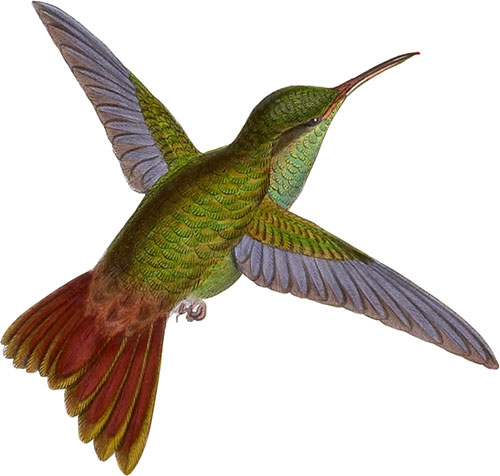Berylline Amazili
Southern Mexico. M. Botta found it at Orizaba, and M. Sallé at Cordova.
This bird is generally known to Trochilidists by the specific name of Arsenoë; but the Berlin ornithologists tell us that it had been previously named beryllinus by the late Dr. Lichtenstein in his priced list of birds issued in 1830; and I have adopted the name proposed by my very old friend who so long filled the post of Director of the Zoological Museum of Berlin: at the same time I question the justice of the procedure, as it can scarcely be expected that names proposed in a catalogue of duplicate birds, even if accompanied by brief specific descriptions, are to be received and admitted by the scientific naturalist; for myself, I have never seen the pamphlet alluded to.
The native country of the Amazilia beryllina is Southern Mexico, where it appears to be numerous; it does not, however, seem to enjoy a very wide range, since I do not recollect ever seeing examples of it in any collection from Guatemala; if it be found there, it is but rarely, and only in the northern parts of the country, or those portions bordering on Mexico. Several specimens were collected by M. Botteri in the neighbourhood of Orizaba, and M. Sallé procured others at Cordova.
A considerable difference occurs in the extent of the green colouring of the under surface in different individuals; in some this colour spreads over the whole of the abdomen, while in others it merely covers the chest and the upper part of the flanks, the breast being of a deep brownish fawn-colour. This variation in the extent of the green colouring I at one time attributed to a difference of sex, the male being generally more clothed with green than the female, but I now think it is merely a local variation.
Head, sides and back of the neck, upper part of the back, and the anterior portion of the wing-coverts dark green, gradually passing into the rich deep golden and purplish bronze of the posterior portion of the wing-coverts, lower part of the back and upper tail-coverts; spurious wing very dark brown; primaries and secondaries dark chestnut-red at the base, and purplish brown for the remainder of their length; tail rich deep purplish bronze, the purple hue prevailing on the four central feathers; chin, throat, chest, and abdomen shining grass-green; under surface of the wing, vent, and under tail-coverts deep chestnut-red, the feathers of the latter part narrowly fringed with white; upper mandible black; under mandible fleshy with a black tip.
The figures are of the size of life. The plant is the Maxillarta Warreana.
 Amazilia corallirostris
Coral-billed Amazili
Amazilia corallirostris
Coral-billed Amazili
 Amazilia Yucatanensis
Yucatan Amazili
Amazilia Yucatanensis
Yucatan Amazili
 Amazilia cerviniventris
Fawn-breasted Amazili
Amazilia cerviniventris
Fawn-breasted Amazili
 Amazilia castaneiventris
Chestnut-bellied Amazili
Amazilia castaneiventris
Chestnut-bellied Amazili
 Amazilia Riefferia
Rieffer’s Amazili
Amazilia Riefferia
Rieffer’s Amazili
 Amazilia Devillei
Deville’s Amazili
Amazilia Devillei
Deville’s Amazili
 Amazilia viridigaster
Green-bellied Amazili
Amazilia viridigaster
Green-bellied Amazili
 Amazilia cyanura
Blue-tailed Amazili
Amazilia cyanura
Blue-tailed Amazili
Featuring all 422 illustrated species from John Gould’s A Monograph of the Trochilidæ, or Family of Humming-Birds arranged by color.